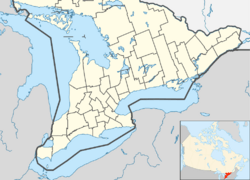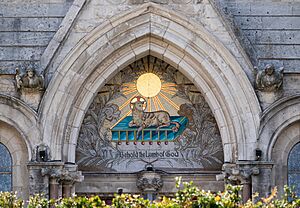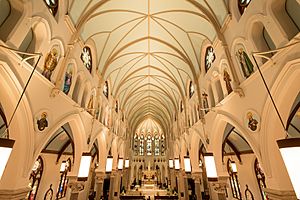Basilica of Our Lady Immaculate facts for kids
Quick facts for kids Basilica of Our Lady |
|
|---|---|
| Basilica Our Lady of the Immaculate Conception | |

Southwest view of the basilica
|
|
| 43°32′35.3″N 80°15′4.2″W / 43.543139°N 80.251167°W | |
| Location | Guelph, Ontario |
| Country | Canada |
| Denomination | Roman Catholic |
| Website | basilicaofourlady.com |
| History | |
| Status | Minor basilica, Diocesan Marian Shrine |
| Dedication | 1883 |
| Architecture | |
| Heritage designation | National Historic Site of Canada |
| Designated | 1990 |
| Architect(s) | Joseph Connolly |
| Architectural type | Norman-Gothic |
| Administration | |
| Deanery | Wellington |
| Diocese | Hamilton |
| Province | Toronto |
The Basilica of Our Lady of the Immaculate Conception is a beautiful Roman Catholic church in Guelph, Ontario, Canada. It is also known as a minor basilica and a parish church. This amazing building was constructed between 1876 and 1888. It was designed by a famous architect named Joseph Connolly. Many people believe it is his best work.
The church is built in the Gothic Revival style. This means it looks like the grand Gothic cathedrals from medieval times. It has detailed carvings and stunning stained glass windows. These were made by very skilled artists. In 1990, the church was named a National Historic Site of Canada. This means it is an important landmark for the whole country. Later, in 2014, Pope Francis gave it the special title of a basilica.
Contents
Building a Landmark: The Basilica's Story
The story of the Basilica of Our Lady began a long time ago. When John Galt founded the city of Guelph in 1827, he set aside the highest point in the town for Roman Catholics. He did this to honor his friend, Bishop Alexander Macdonell. A road leading to this hill was even named Macdonell Street.
According to old records, Galt wrote something special about this spot. He said that one day, a church would rise on this hill that would be as grand as St. Peter's in Rome.
The Basilica of Our Lady Immaculate is actually the third church to stand on this important hill. The first church was a wooden one called St. Patrick's. It was built by 1835 and was the first building in Guelph to be painted inside and out. Sadly, it burned down in 1844.
After that, construction began on St. Bartholomew's Church. This new building was finished in 1846. The current church, the Church of Our Lady, started being built in 1877. Its design was inspired by the famous Cologne Cathedral in Germany.
Designing a Masterpiece
The architect for the current church was Joseph Connolly. He was an Irish-Canadian architect who had designed many churches. He used local limestone to build the Church of Our Lady. It was designed in a style called High Victorian Gothic Revival. This style was inspired by the grand medieval cathedrals found in France.
The church has two tall towers and a large rose window. It also features pointed windows and an interior with chapels that spread out from the main altar area. A skilled local artist named Matthew Bell created some of the beautiful carvings. He worked on both the outside and inside pillars of the church. Sadly, he passed away in 1883 from an injury while working on the building.
In 1888, about twelve years after construction started, the church was dedicated. It was named in honor of Our Lady Immaculate. The two tall towers, which reach over 200 feet (61 m) high, were not finished until 1926. The entire construction project took more than 50 years! This makes it one of the longest building projects in Guelph's history.
Modern Updates and Special Honors
In 1958, a new entrance was added to the church from Macdonell Street. Other than that, the outside of the church has looked much the same since 1926.
A big restoration project for the church began in 2007 and was completed in 2014. This work cost over $12 million. It included fixing the towers, roof, windows, and doors. The inside of the church also got a makeover. New lighting, new flooring, and new pews were installed. A new altar, a baptismal font, and a pulpit were added too. The basement hall was also renovated.
In 2019, Bishop Douglas Crosby gave the church a special title: a "Diocesan Marian Shrine." This means it's a special place for people to honor Mary, the mother of Jesus. Later that year, Pope Francis approved a special ceremony to crown the statue of Mary inside the basilica. This crowning ceremony finally took place on October 1, 2022.
Architectural Features and City Views
The Basilica of Our Lady is a great example of French Gothic Revival architecture. It has a cross-shaped layout with side aisles and a main nave. The church features tall, pointed arches and large rose windows. The two square towers on the front have pointed tops. The outside walls have many detailed carvings and stained glass windows.
Inside, the church continues the Gothic Revival style. It has tall, pointed windows and beautiful stained glass. There are also granite columns with carved tops that support the arches. The ceiling has a special ribbed design. The church is known for its high-quality design and craftsmanship. This includes its wood and stone carvings, stained glass, and even its excellent sound quality.
Protecting the View
The city of Guelph has special rules to make sure everyone can see the Church of Our Lady. These rules create "protected view areas" in the downtown area. This means that new buildings or communication towers built in the city center cannot block the view of the church. Also, for a long time, no new buildings in Guelph were allowed to be taller than the church.
However, a new parking garage built in 2019 does block some views of the church from certain spots downtown.
See also
 In Spanish: Basílica de Nuestra Señora Inmaculada (Guelph) para niños
In Spanish: Basílica de Nuestra Señora Inmaculada (Guelph) para niños
- List of churches in the Roman Catholic Diocese of Hamilton, Ontario









